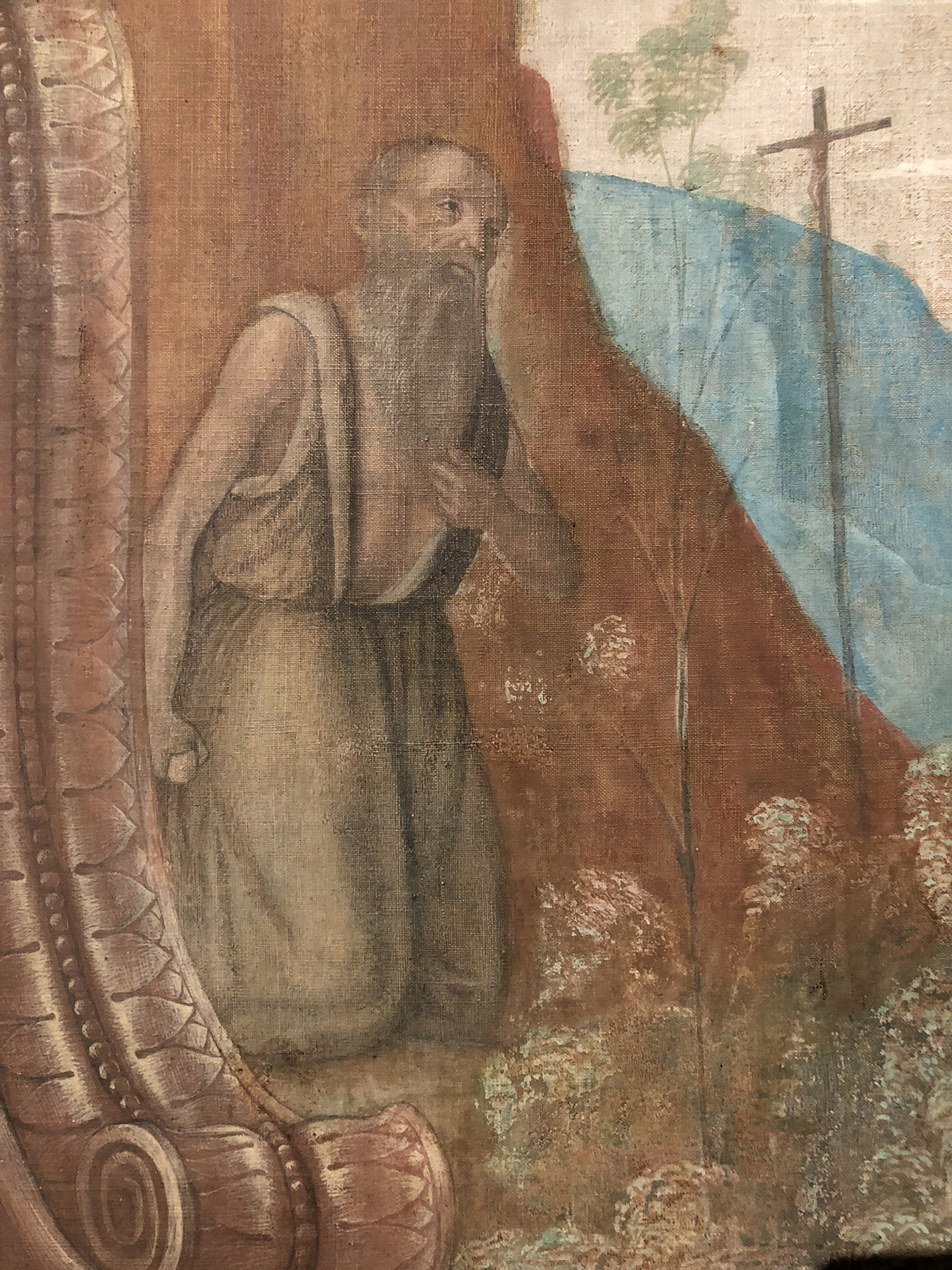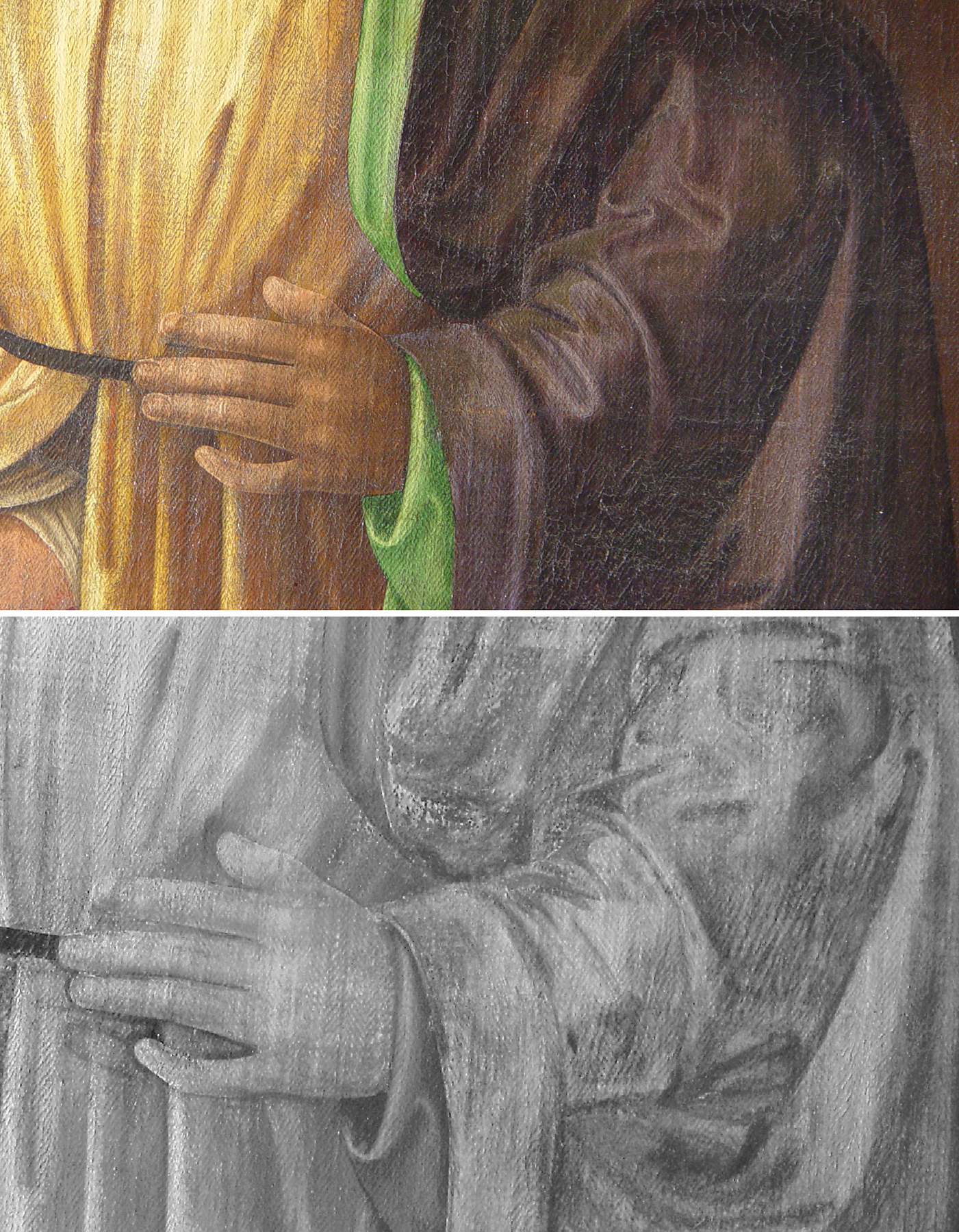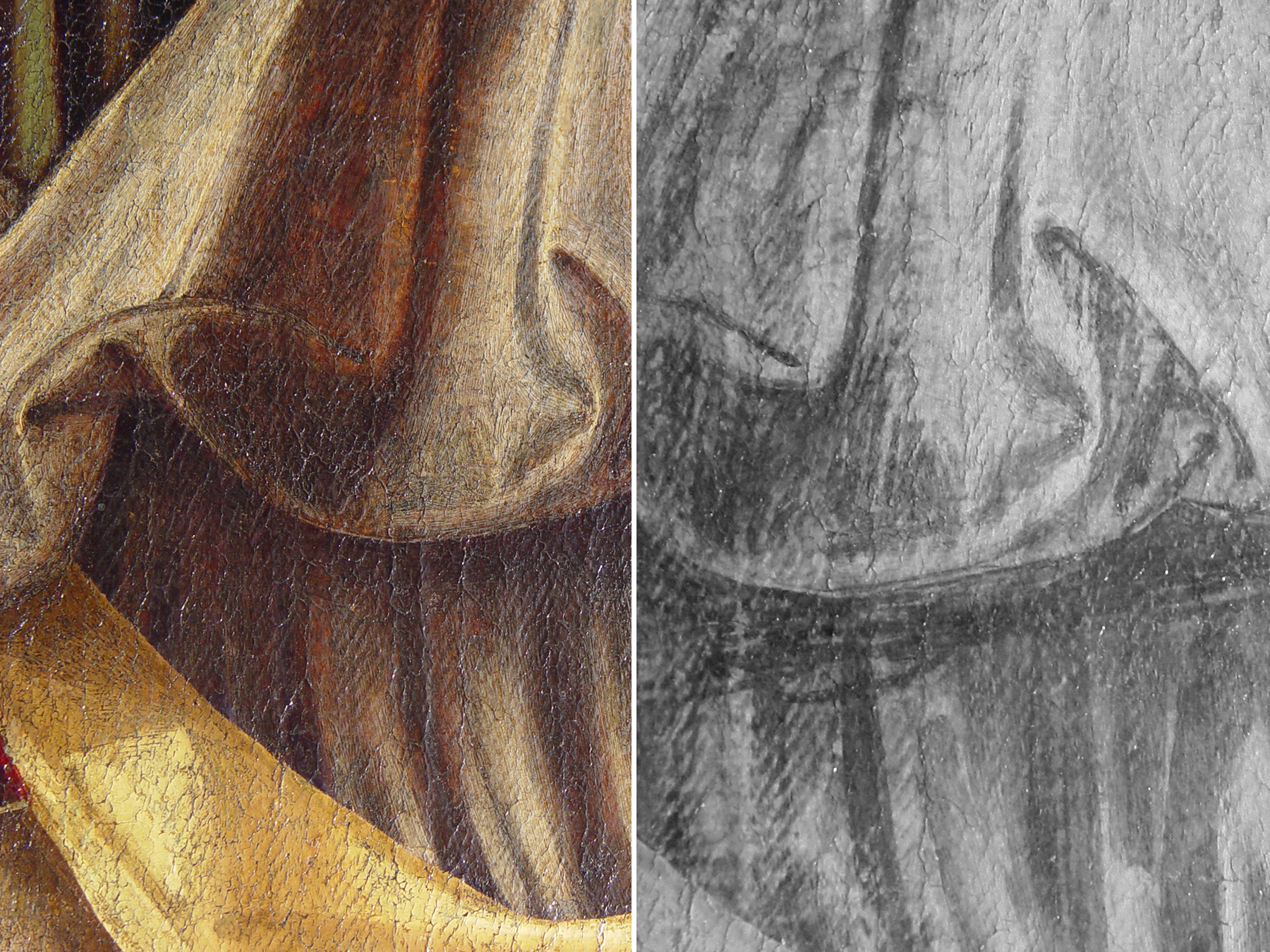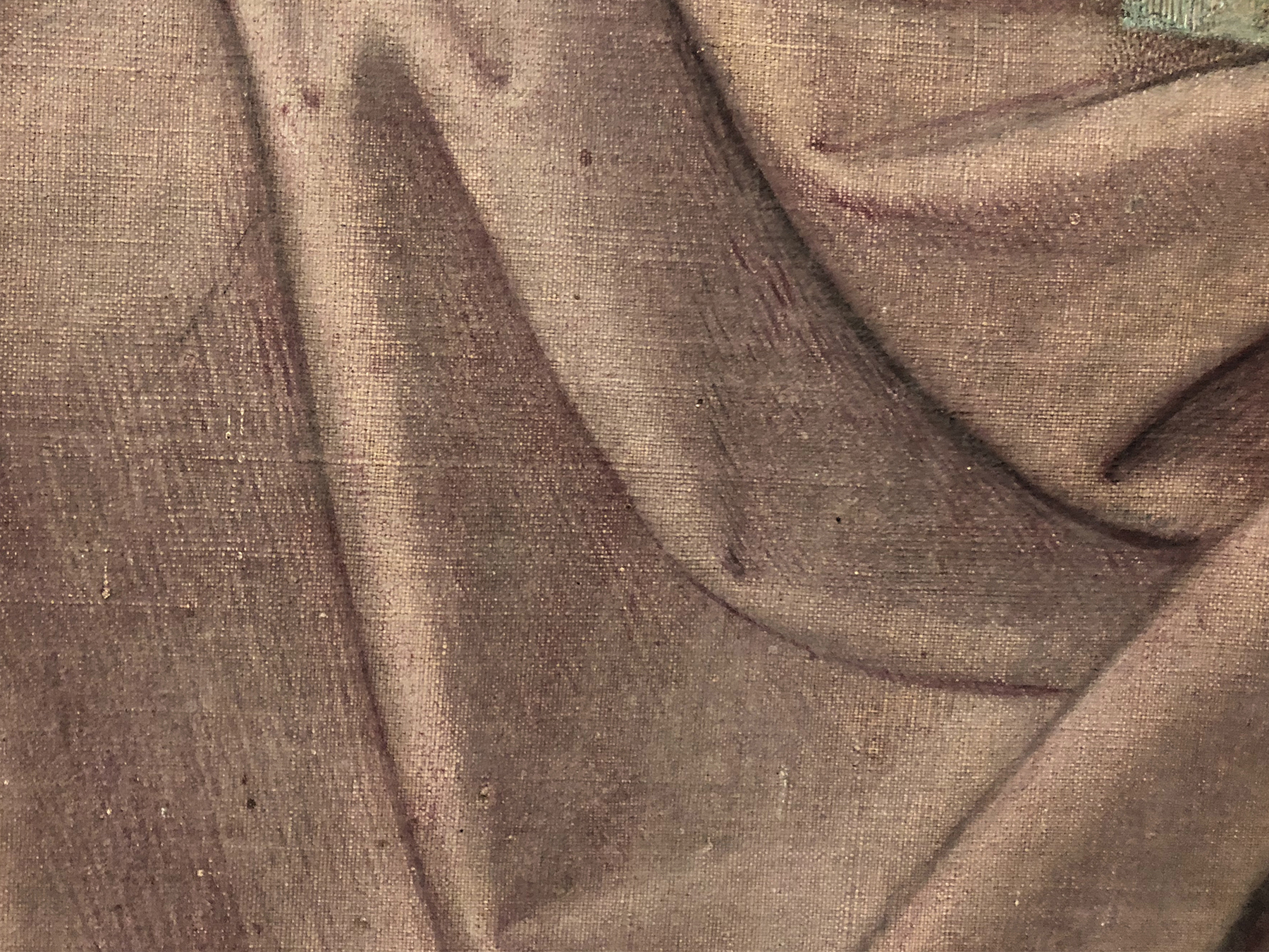Technical Peculiarities in Giovanni Santi’s Paintings on Canvas
Gianluca Poldi, Maria Letizia Amadori, Valeria Mengacci
Introduction
Giovanni Santi (Colbordolo ca. 1439–Urbino 1494), known as the father of Raphael, is one of the most important painters active in Urbino during the last decades of the fifteenth century. He enjoyed great prestige at the court of Montefeltro, where he was admired for both his painting skills and his work as a scenographer. Santi is recorded as joining the workshop of his father, Sante di Peruzzolo, in 1484 (the year of Peruzzolo’s death), where he specialized in fine arts and crafts.1 Among Santi’s known paintings, we can cite the cycle of the Muses for the so-called Tempietto of the Ducal Palace in Urbino (commissioned by Federico da Montefeltro), the mural paintings in the Tiranni Chapel in Cagli (Marche region), as well as some altarpieces and smaller devotional works. By 1493 his fame as a portrait painter had brought him to the court of Isabella d’Este in Mantua. He was also known to be a humanist, as testified by his poem “La vita e le gesta di Federico di Montefeltro duca di Urbino” (The life and deeds of Federico di Montefeltro, Duke of Urbino),2 which was written at the beginning of the 1480s.
The catalog of the exhibition that took place at the Palazzo Ducale in Urbino in 2018 added new information on Santi’s biography and artistic activity.3 In addition, a great deal of data concerning the drawing, pictorial technique, and painting materials related to twenty-eight artworks by Santi dated to different periods were presented.4 The diagnostic campaign combined multispectral imaging techniques in the visible such as infrared (IR) and ultraviolet ranges (UV), reflectance spectroscopy (performed in an extended visible range), X-ray fluorescence spectroscopy (ED-XRF), with micro-invasive investigations such as polarizing light microscopy (PLM); and environmental scanning electron microscopy with energy dispersive X-Ray (ESEM-EDX).5
This paper presents the results achieved with respect to Santi’s canvas paintings: Tobias and the Archangel Raphael and Saint Roch (Figs. 1, 2), made on herringbone fabric, by comparing them with other early Italian canvas paintings. Two questions arise: did Santi choose these supports for technical reasons (size or mechanical necessities), or did visual factors also play a role, whereby the artist also aimed to exploit the vibrant surface effect of this painting fabric.6 Certainly, the use of herringbone-weave canvases during the last decades of the fifteenth century presents a rarity within the context of Urbino, and indeed the entire Italian peninsula at this date, as we will discuss.
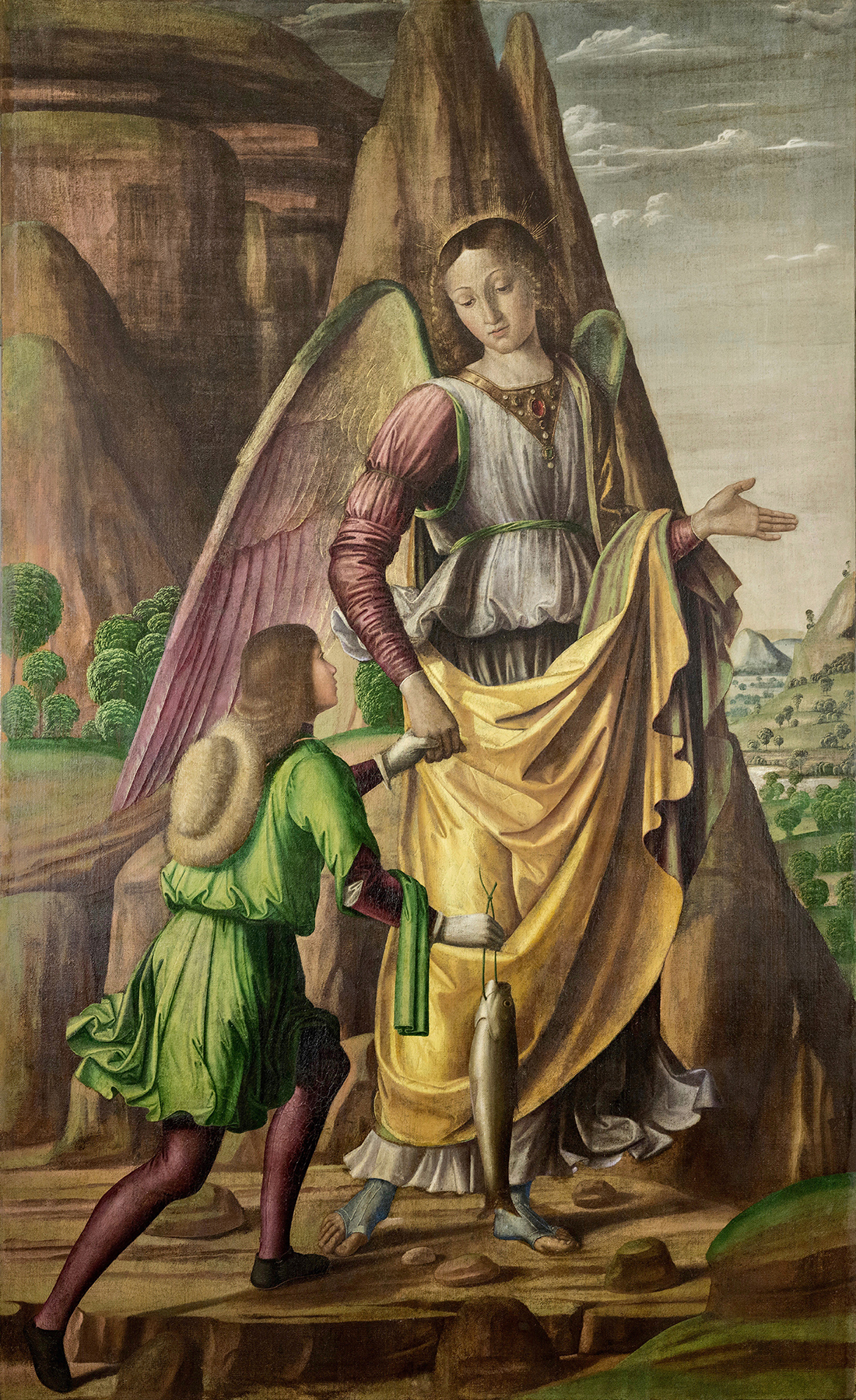 Fig. 1
Fig. 1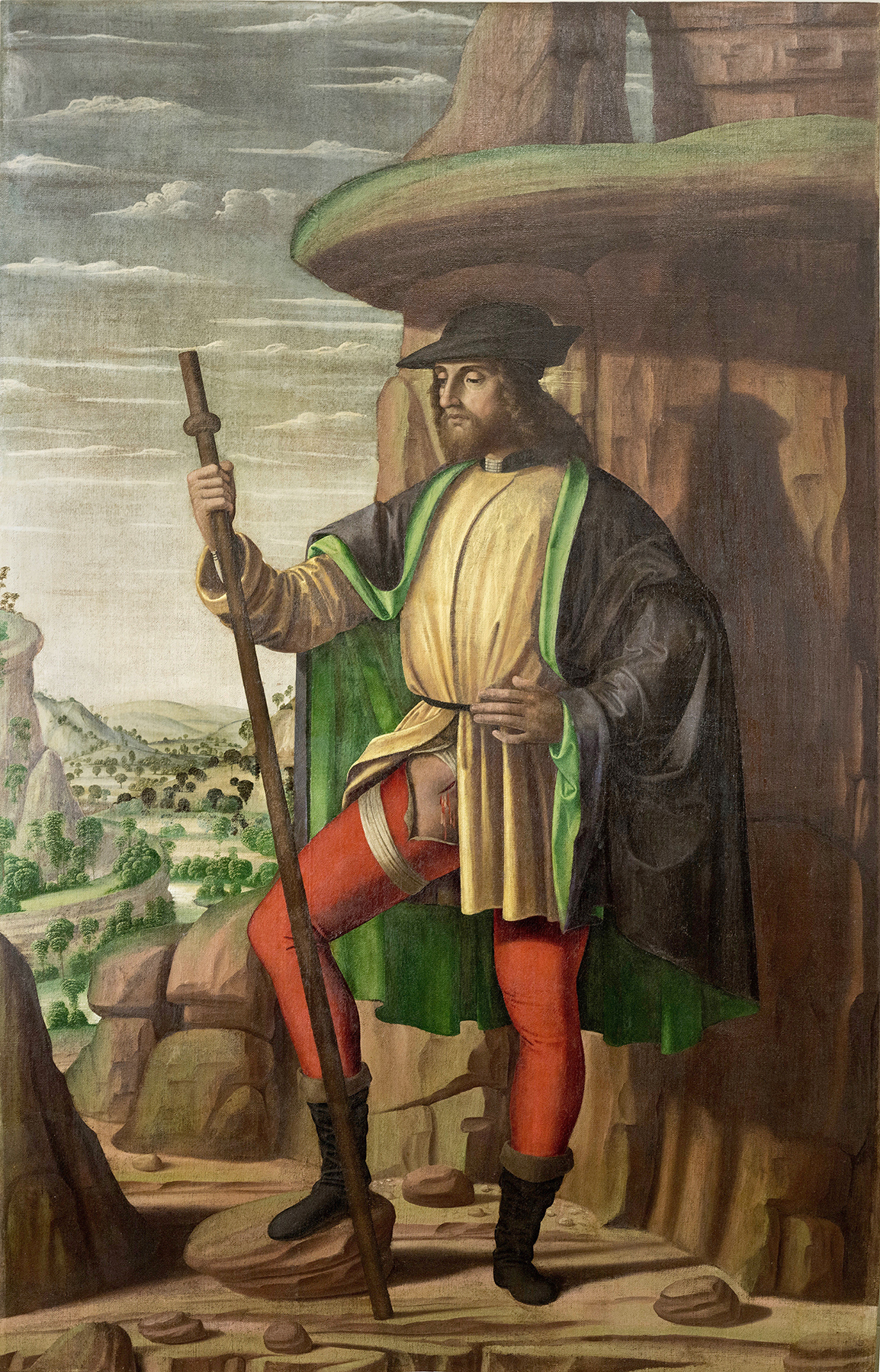 Fig. 2
Fig. 2Santi’s Paintings on Canvas
Santi was above all a painter of panels, with only three surviving canvases almost unanimously attributed to him by critics: Saint Jerome (Fig. 3) of the Vatican Museums (82 11/16 x 66 15/16 in. [210 x 170 cm]), which was painted on a plain-weave canvas and still shows influence of the technical methods of some Northern European paintings; Tobias and the Archangel Raphael (96 7/16 x 62 3/16 in. [245 x 158 cm]) and Saint Roch (95 11/16 x 57 7/8 in. [243 x 147 cm]), both painted on herringbone-weave canvas, and both in the collection of the Galleria Nazionale delle Marche and housed in the Museo di Casa Raffaello (Raphael House) in Urbino. Saint Jerome is generally dated to the mid-1470s,7 and the two canvases of Urbino are dated to the early 1490s (1490–94).8
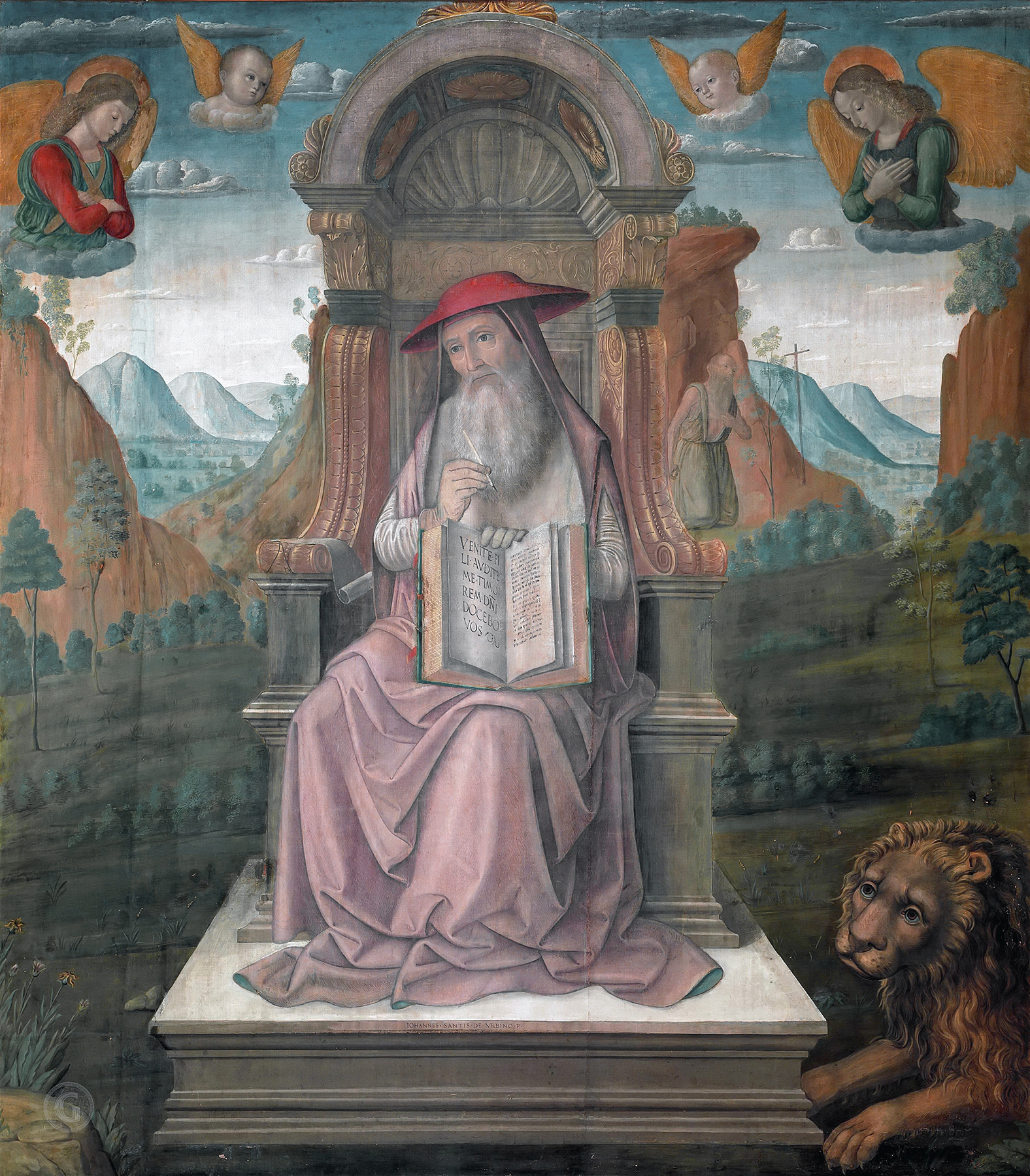 Fig. 3
Fig. 3Due to the absence of provenance records relating to the two canvas paintings in Urbino, there remains disagreement among art historians as to their original location, patronage, and decorative function,9 leaving several questions open. Later sources document that both paintings were in the Church of San Francesco in Urbino, where they are recorded by the writer Marcello Oretti in 1777 as being present at the sides (“ai lati”) of the chapel of Saint Sebastian. The same paintings were also recorded as being seen by David J. Passavant in 1839, at which time they were present in the same chapel, but now placed on the sides of the larger painting Sacred Conversation with the Baptist, the Saints Francis of Assisi, Jerome and Sebastian, and the Buffi family (the so-called Buffi Altarpiece, oil on arched panel, 129 x 87 in. [330 x 221 cm]). This large-scale altarpiece can be dated to ca. 1489 through a document recording the commission of the Saint Sebastian altar for this church. The present authors agree with the art historian Ranieri Varese10 that these documents do not necessarily indicate that the two canvases were part of the original arrangement of the Buffi Altarpiece. Indeed, their reconstruction as a triptych in the 2018 exhibition dedicated to the painter revealed significant discrepancies between the various parts. First, the notable differences in the sizes of the three paintings and in the choice of support dissuaded us from considering them as forming an original single complex. In addition, the absolute lack of compositional unity as evidenced by the relationship among the background elements, including the clouds, the hills, and the lower foreground, are also inconceivable for a work of this particular date and cultural context.
Painting on Canvas in Italy
Discussion of the Italian context regarding canvas supports can be of help to better identify the rarity of Santi’s choice of herringbone, not only within the Marche region but also of the larger central Italian area.
Herringbone-weave canvas very seldom appears in the fifteenth century as a painting support, although its use did become more frequent during the course of the following century. This kind of fabric was more robust and rough, but also more elastic than plain weave, and it was preferred in the sixteenth century, particularly in Venice,11 perhaps because it was perceived to be particularly suitable for a type of painting with dense and irregular brushstrokes, and for large formats.
In the fifteenth century, linen canvases with a basic square-weave pattern (i.e., plain weave) and a 1:1 weft-warp correlation are prevalent. This type of support is characteristic of processional banners, such as the one now in the Ducal Palace of Urbino depicting the Baptism of Christ on the front and the Preaching of the Baptist on the back (ca. 1472–74, 63 x 44½ in. [160 x 113 cm]), a work attributed by some scholars to the young Santi,12 despite some clear differences in technique, including its underdrawing. The plain-weave pattern is characteristic of canvases painted with egg or glue tempera (distemper), a medium preferred by Andrea Mantegna. Such paint mixtures were sometimes applied directly onto the linen, without the use of a ground preparation, as seen in northern European Tüchlein paintings, and less frequently in Italy.13 In Italy the first examples of oil painting on canvas (plain weave) date to around the middle of the fifteenth century, and include Donato de’ Bardi’s Crucifixion (ca. 1448, 65 x 93 1//16 in. [165 x 238 cm], Pinacoteca Civica, Savona) and Paolo Uccello’s St. George and the Dragon (1460–70, 21 7/8 x 29 ¼ in. [55.6 x 74.2 cm], National Gallery, London).14 In addition, there are a few early examples of Italian oil paintings on canvas where the less common twill and herringbone patterns were used, as in some of the enormous canvases by Carpaccio belonging to the cycle of the Stories of Saint Ursula (1490–98, Gallerie dell’Accademia, Venice), where different types of canvas are sometimes sewn together15. For example, a part of the Arrival of the English Ambassadors (108¼ x 231 7/8 in.) [275 x 589 cm]) is painted on twill canvas, as well as a section of the Dream of St. Ursula (107 7/8 x 105 1/8 in. [274 x 267 cm]), while the Return of the Ambassadors to the English Court (117 x 207 7/16 in. [297 x 527 cm]) has a herringbone support,16 and the others have a plain-weave support. A herringbone fabric was also used in Vicenza by Bartolomeo Montagna for an oil (and tempera?) painting, the Madonna Adoring the Child between the Saints Monica and Magdalene (ca. 1485, 72 7/16 x 66 9/16 in. [184 x 169 cm], Pinacoteca Civica di Palazzo Chiericati, Vicenza).17 In the same area, about twenty years earlier, it was employed in the Madonna with Child and the Saints John the Baptist and Paul (66 1/8 x 85 13/16 in. [168 x 218 cm], Church of St. Francis, Schio), attributed to the master of the polyptych of Arzignano, where the binder appears to be a proteinaceous medium.18 A herringbone-weave canvas was also used by Michele da Verona to paint the Crucifixion (1501, oil on canvas, 131 7/8 x 283 7/16 in. [335 x 720 cm]), now in the Pinacoteca di Brera, Milan19.
With regard to twill-weave canvases, early examples include the Crucified Christ (ca. 1436, 123 5/8 x 75 in. [314 x 190.5 cm], egg and glue tempera on canvas, Castelvecchio Museum, Verona) by Jacopo Bellini,20 and the smaller Virgin and Child with the Magdalen and Saint John the Baptist, an altarpiece by Mantegna in the National Gallery of London (ca. 1500, 54¾ x 46 in. [139.1 x 116.8 cm]).21
Santi’s Textile Supports
The original support used for Tobias and the Archangel Raphael consists of two pieces of canvas sewn vertically: the left strip measures 35 7/16 inches (90 cm) in width, whereas the right measures only 20 1/8 inches (51 cm) in width; both are 97 7/16 inches (245 cm) in length. The canvas used for Saint Roch similarly consists of two pieces of canvas sewn vertically, 95 11/16 inches (243 cm) in length, with the left strip measuring 18 1/8 inches (46 cm) in width and the right strip 35 7/16 inches (90 cm).22 According to investigations made using ESEM-EDX, the canvas supports used for Tobias and the Archangel Raphael and Saint Roch are made of linen.
As part of a previous conservation intervention, which took place in the 1970s, the two canvases of both paintings were lined and mounted onto new auxiliary stretchers. About twenty years earlier, in Saint Jerome (Fig. 3)—previously mentioned but not yet examined through diagnostics—close observation of the painting’s surface showed the artist’s use of a plain-weave canvas support, a choice that Santi could have made based on his knowledge of contemporary Flemish works on canvas. Significant examples include the paintings of Justus van Ghent (c. 1410–c. 1480, act. Urbino ca. 1473–1475), who is documented as having painted on canvas for the Confraternity of Corpus Domini in Urbino.23 The canvas of Santi’s Saint Jerome is made of three vertically sewn stripes (66 15/16 in. [170 cm] total width), the central one being about 35 7/16 inches (90 cm) wide, and the narrower one on the left probably elongated with an addition at the bottom.
In the three canvas paintings, the paint layers have been executed on a white ground preparation, which was applied so thinly that the texture of the canvas is clearly visible on the surface (Fig. 4).
Underdrawing
Infrared reflectography of Santi’s panel paintings revealed the presence of an underdrawing made with a carbon-based ink.24 The style of the underdrawing is quite characteristic of Santi’s technique, with its typically fluid, modulated, and continuous use of line. For some paintings, this contour drawing was used alongside a dense hatching, with an inclination that is mainly top right to bottom left, but it is not fixed; the direction of the hatching easily varies to follow the volume and the shape of the different parts of the object, sometimes passing from diagonal to vertical to the opposite diagonal, suggesting that the author was a versatile draftsman. This variety, even within the same figure, prevents us from clearly establishing whether Santi was right-handed or left-handed. The hatching is sometimes more elaborate and accurate, sometimes quicker and less frequently seen, and elsewhere found only under some figures where he wanted to clearly express the shades and shadows to be followed by paint.
Hatched underdrawing was also specifically found in the two canvases of Tobias and the Archangel Raphael and Saint Roch, particularly in the draperies, although in these paintings the underdrawing technique was less discernible using IR imaging than in other works by Santi. This is due to the diagonal pattern of the herringbone weave interfering with the slanted direction of the drawing. In addition, certain aspects of the paintings’ conditions also make it difficult to read the underdrawing: the reflectographic images show the presence of numerous abrasions throughout the composition—more widespread in the darker areas of the rocks and figures. The hatching, which is not always regular, was developed by Santi for various shadows, most likely to facilitate the final shading. In fact, it is more frequent where the painter made use of semitransparent glazes, as seen in the areas containing red lakes (Figs. 5, 6).
These two paintings, which can be regarded as among Santi’s best works in terms of pictorial quality and rendering of the figures, are drawn and painted with great accuracy. Few changes are visible: in Tobias and the Archangel Raphael, the position of Tobias’s left leg was shifted slightly, seemingly in order to prevent his foot from touching that of the angel (Fig. 7). In addition, the horizontal folds in the sleeve of the archangel’s red robe were altered to start closer to the shoulder. In Saint Roch, minor corrections were made to some of the outlines, as seen in the rocks and in the tip of the figure’s hat, which was reduced slightly, as well as the placement of his left hand, initially drawn a little further to the left (Fig. 5).
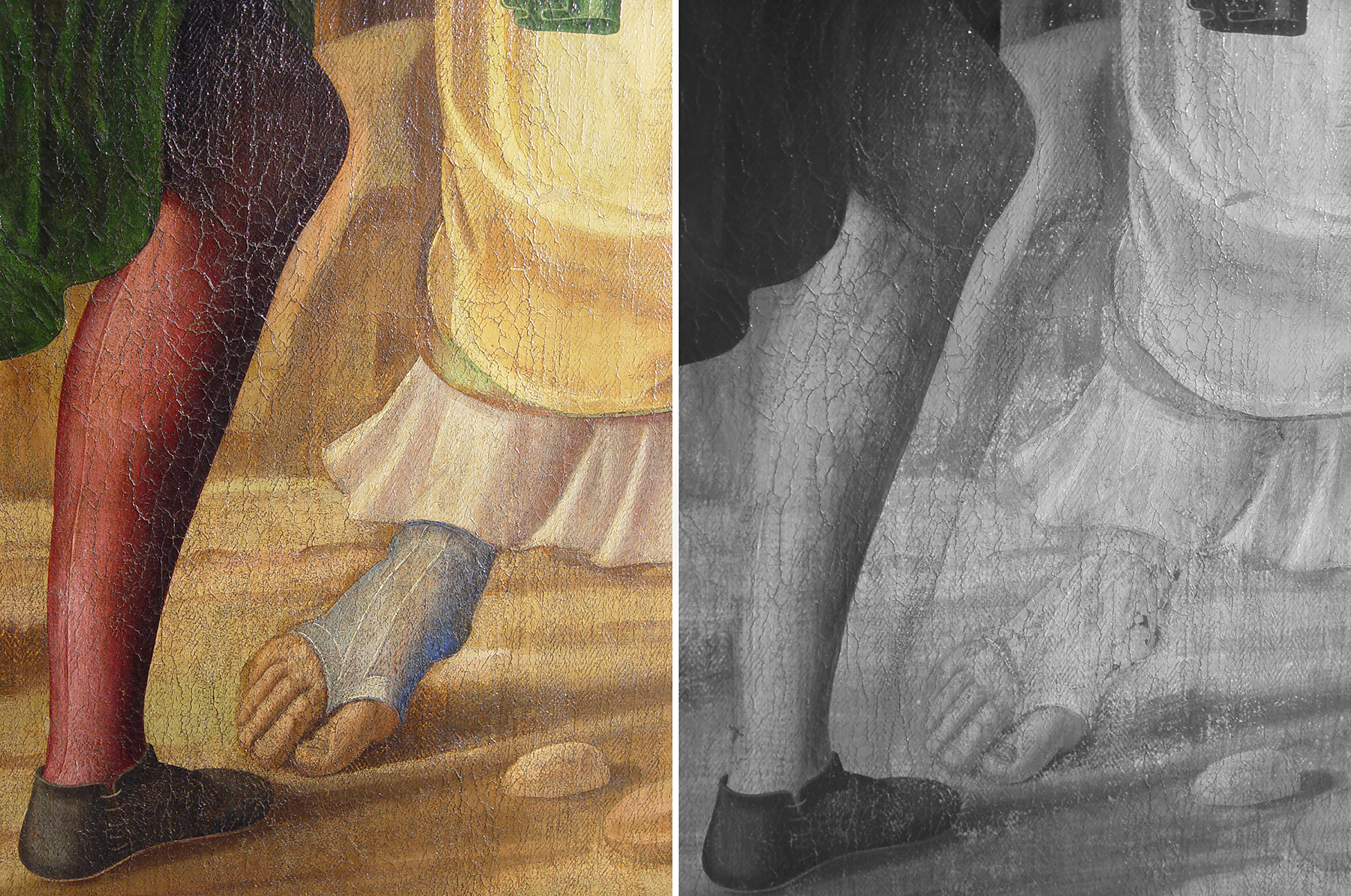 Fig. 7
Fig. 7As seen in other paintings by Santi, the relative absence of large-scale compositional changes, as well as the confident, fluid handling of the underdrawing, both point toward the artist’s use of cartoons, transferred perhaps using carbon paper or through pouncing, then accurately brushed out to avoid dirtying the subsequent layers of paint. In comparison to Santi’s panel paintings examined, here the underdrawing, where it can be seen, tries to build volume as well as shadows, as seen in Saint Roch’s mantle.
Painting Materials, Powdered Glass, and Layer Structure
The technical examination of Santi’s panel paintings has revealed a palette consisting of: lead white, lead-tin yellow, orpiment, ochers, hematite and earth pigments, vermilion, two different red lakes (cochineal and madder), natural ultramarine, azurite, indigo, copper-based pigments (verdigris), carbon black, and bone black.25 With the exception of indigo and madder—each one found only in one of the examined paintings—this palette range was also employed by Santi for the two canvases at Casa Raffaello.
Santi used these pigments in traditional mixtures and, for paintings on mobile supports, employing different binders, combining both drying oils and proteinaceous binders within the same painting, choosing different media for different colors or mixing them, as in the Martyrdom of St. Sebastian (c. 1477–1478, panel, 82 11/16 x 65 3/8 in. [210 x 166 cm], Galleria Nazionale delle Marche, Urbino, long-term loan to Museo di Casa Raffaello), the Visitation (86 ¼ x 69 11/16 in. [219 x 177 cm], panel, Chiesa di Santa Maria Nuova, Fano),26 and the Virgin and Child (c. 1480, oil and egg tempera on panel, 26 11/16 x 19¼ in. [67.8 x 48.8 cm], National Gallery, London).27
Using ESEM-EDX, colorless powdered glass was detected in red and green glaze layers of Tobias and the Archangel Raphael, which we can interpret as being related to the artist’s experimentation with the oil binder. The same use of colorless powdered glass was also found in the other paintings by Santi examined as part of this research. In this instance, it is probable that Santi was once again influenced by Justus of Ghent. The latter painted the Communion of the Apostles (c. 1473–1474, oil on panel, 113 3/8 x 126 3/8 in. [288 x 321 cm], Galleria Nazionale delle Marche, Urbino) for the Confraternity of Corpus Domini,28 as well as the series of the twenty-eight Uomini illustri (Illustrious men) for the studiolo of Federico da Montefeltro in the Ducal Palace of Urbino, today divided between Urbino (Galleria Nazionale delle Marche) and Paris (Musée du Louvre), both of which have been shown to contain colorless powdered glass.29
For Santi’s two Urbino canvases, the linen supports were prepared with a thin layer of gypsum and glue, each with a maximum thickness less than 100 µm, which allowed the herringbone weave of the canvas to remain visible on the surface (Fig. 8a–c).
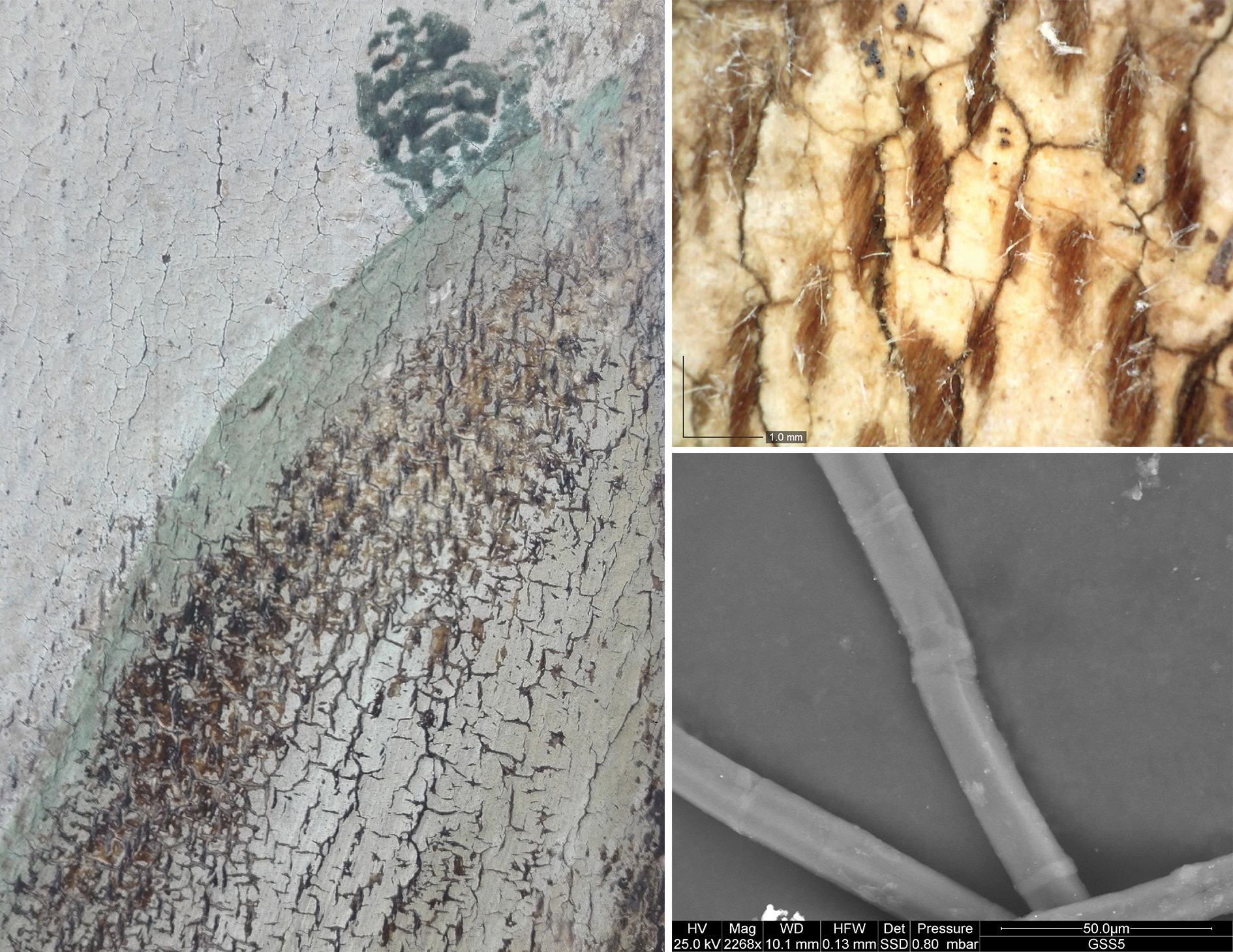 Fig. 8
Fig. 8Technical analysis has shown that Santi made extensive use of lead white in the underlayers and flesh tones of the paintings. The blue of the sky was painted with an abundant amount of lead white mixed with azurite (vis–RS absorbance band around 630–640 nm). The same mineral blue pigment was also used to paint the distant mountains in the background. During this research it was not possible to confirm whether natural ultramarine was used in the sky, as the presence of surface dirt on both paintings complicated the non-invasive diffused reflectance (vis-RS) spectra readings gained from this area. The rocks present behind the figure of Saint Roch were painted with a thick layer of lead white, ocher, and various earth pigments, as well as the occasional use of vermilion, which was glazed in some areas with thin strokes of verdigris (copper acetate). The presence of verdigris was also confirmed in the brighter areas of the composition using vis-RS, where the results presented the pigment’s typical absorbance bands in the range 700–720 nm. In other cases, verdigris was also found mixed with lead-tin yellow, for example in the skillfully painted crowns of the light green trees in the mid-ground. In contrast, the darker trees visible in the distant background were found to contain verdigris alone. Similar painting materials and paint mixtures were also identified for Tobias and the Archangel Raphael.
The red and pink hues of the paintings were obtained using various red pigments, depending on the desired shade, with vermilion, red lake, hematite, and red ocher being identified. In both works, the flesh tones were made using abundant amounts of lead white mixed with small amounts of vermilion, ocher, and earth pigments (these latter were found to be particularly abundant in the darker flesh tones of Saint Roch). In Saint Roch, the bright red hue of the saint’s trousers was obtained with lead white and vermilion, and the addition of a red carmine type–based lake used as a glaze in the shadows. The presence of this type of red lake, derived from coccid insects (such as kermes or cochineal) was identified by its characteristic absorbance bands in the vis-RS spectra, at 530 and 570 nm.30
The presence of manganese was detected in both paintings using ED-XRF, notably in the purple stockings of Tobias, as well as in the red robe of the Archangel Raphael. This in turn confirms Santi’s use of glass for the paint mixtures of the two works, associated in these cases with the layers of red lake and other thin oil glazes. The presence of precious natural ultramarine, mixed together with a cochineal-based lake (a mixture often used by Santi for his panel painting) was also detected in the deep purple of the mantle of Saint Roch, as well as in the purplish pink of the Archangel Raphael’s sleeves. Ultramarine was further identified in the angel’s blue-grey shoes, where it was found mixed only with lead white.
The technique used in the build-up of the painting layers was clarified and deepened by stratigraphic investigations as below. The yellow colour of Saint Roch’s robe was found to have been made using various mixtures of lead-tin yellow, mixed with lead white in the highlights, or with yellow ocher and earth pigments in the midtones and the shadows. For the Archangel Raphael’s mantle (Fig. 9a–c), Santi used a similar layer structure, applying at first a thick yellow brushstroke (83-µm thick), consisting of lead-tin yellow (probably type I due to the absence of silicon,31 but further analyses such as Raman would be needed for confirmation) with small amounts of hematite and earth pigments, followed by a glaze layer using the same earth pigments mixed with bone black.
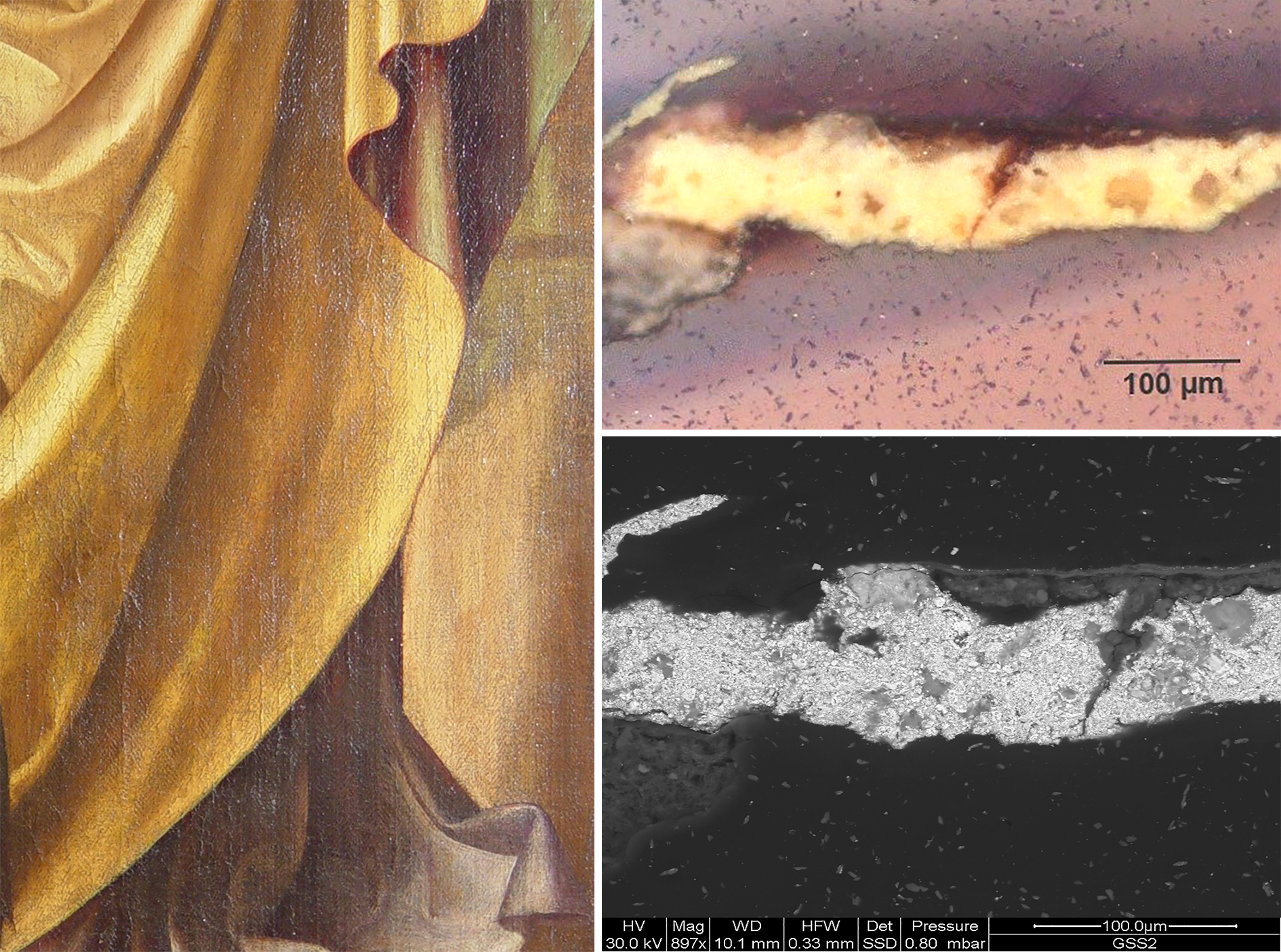 Fig. 9
Fig. 9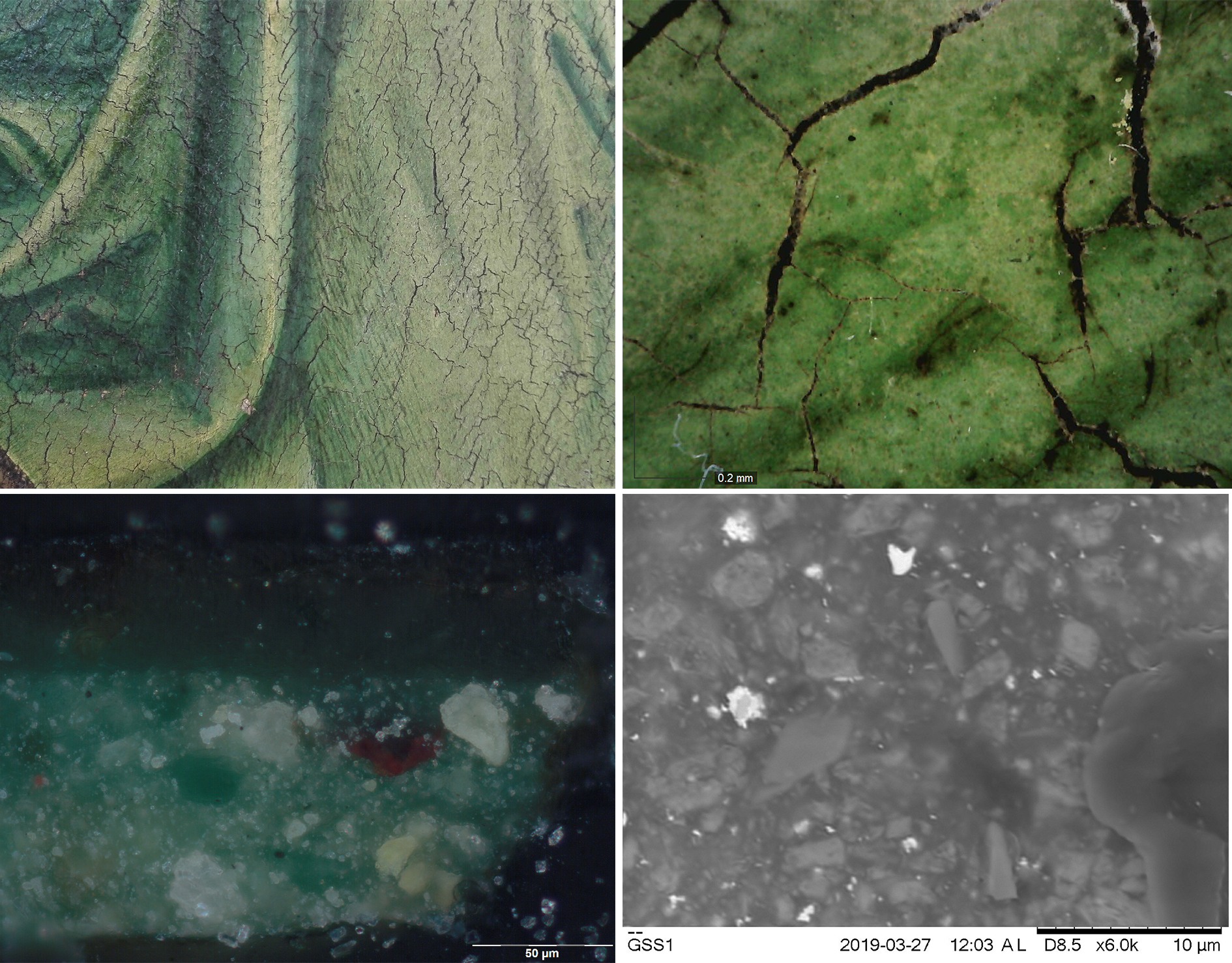 Fig. 10
Fig. 10The green color of Tobias’s robe (Fig. 10a–d) consists of two paint layers. The first is light green in colour (50-µm thick) and composed of a green copper-based pigment (60-µm thick) mixed together with lead white, lead-tin yellow, and a few scattered particles of orpiment. The second, darker paint layer consists of the same copper-based pigment (identified as verdigris using vis-RS analysis) mixed with lead-tin yellow and finely ground glass particles, the latter of which are probably related to Italian-produced lime-sodium glass.32 The shadows above consist mainly of a copper-based pigment, as well as small amounts of orpiment.
A detail photograph taken of Tobias’s green robe (Fig. 10a) shows another peculiar feature of Santi’s technique; namely his use of diagonal hatched lines—painted from top left to bottom right, as more typical of someone left-handed—like a finishing touch on the paint layers, seemingly as a means of emphasizing the midtones. This particular type of handling was observed solely in some of the red (Fig. 11) and green fabrics within the two works, and further appears to be related to the underdrawing, albeit applied in a more regular manner. The same kind of hatched handling was also observed for the midtone layers in the red lake cloak of Saint Jerome (Fig. 12).
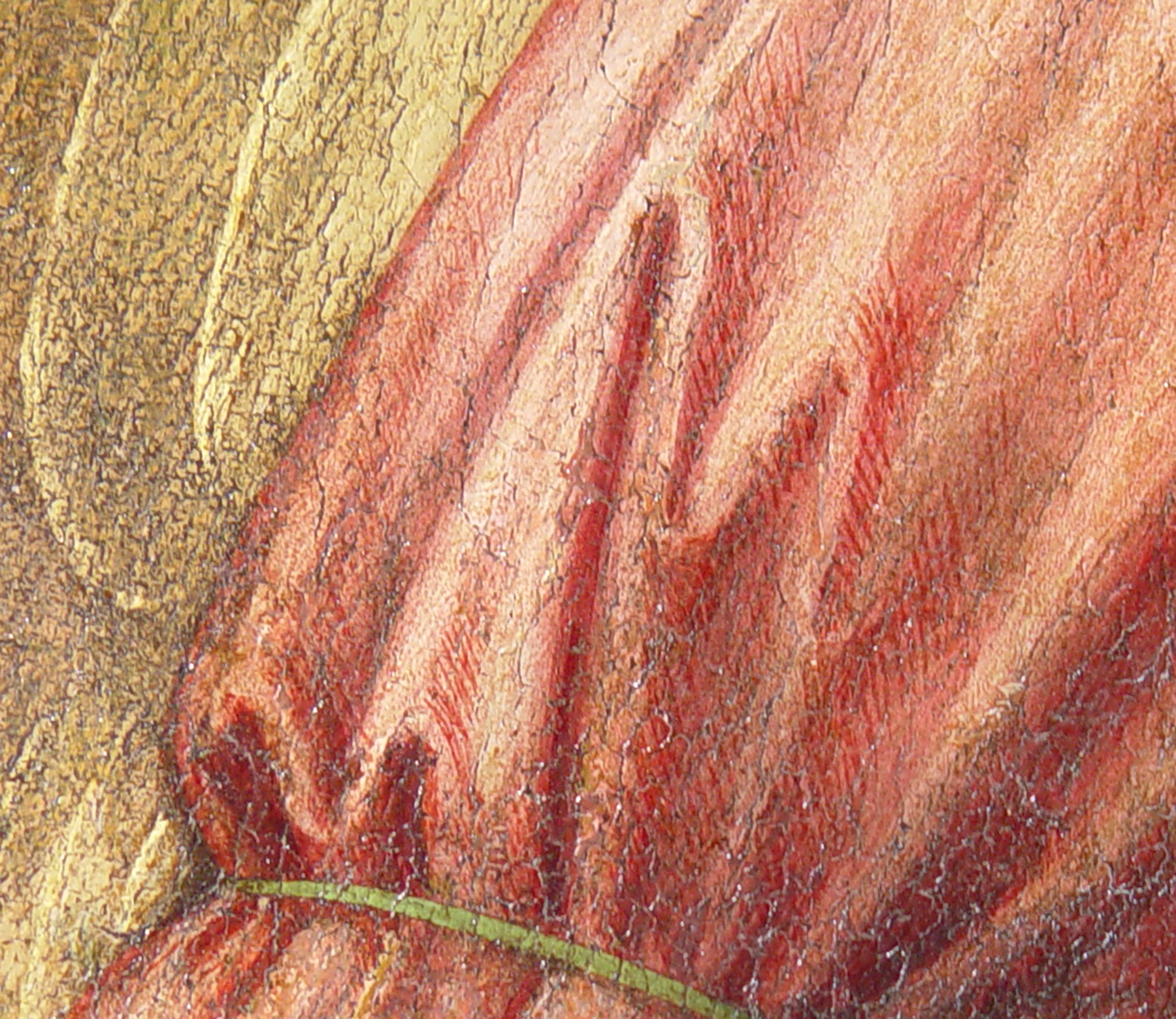 Fig. 11
Fig. 11
The use of detailed hatched handling in the uppermost paint layers is something that can be regarded as characteristic of Santi’s personal technique and should therefore be viewed as a feature that was most likely not carried out by apprentices or workshop pupils. Based on this, the presence of such hatched marks in Saint Roch and Tobias and the Archangel Raphael serves to strengthen the claim that they were painted by Santi himself, and not by a collaborator, thereby rejecting the hypothesis made by Vastano.33
For the red sleeve of the archangel’s dress (Fig. 13a–d), Santi applied a thick layer of paint (130-µm thick) containing red lake, lead white, and glass particles. This layer was then covered with a red lake glaze, which was further modified using glass particles in order to make the paint more transparent.
The violet-colored surcoat of the archangel was constructed using a thin layer (10-µm thick) of red lake, followed by highlights (40-µm thick) composed of lead white and red lake particles, with additions of natural ultramarine, as seen in the photomicrograph image (Fig. 14a–d).
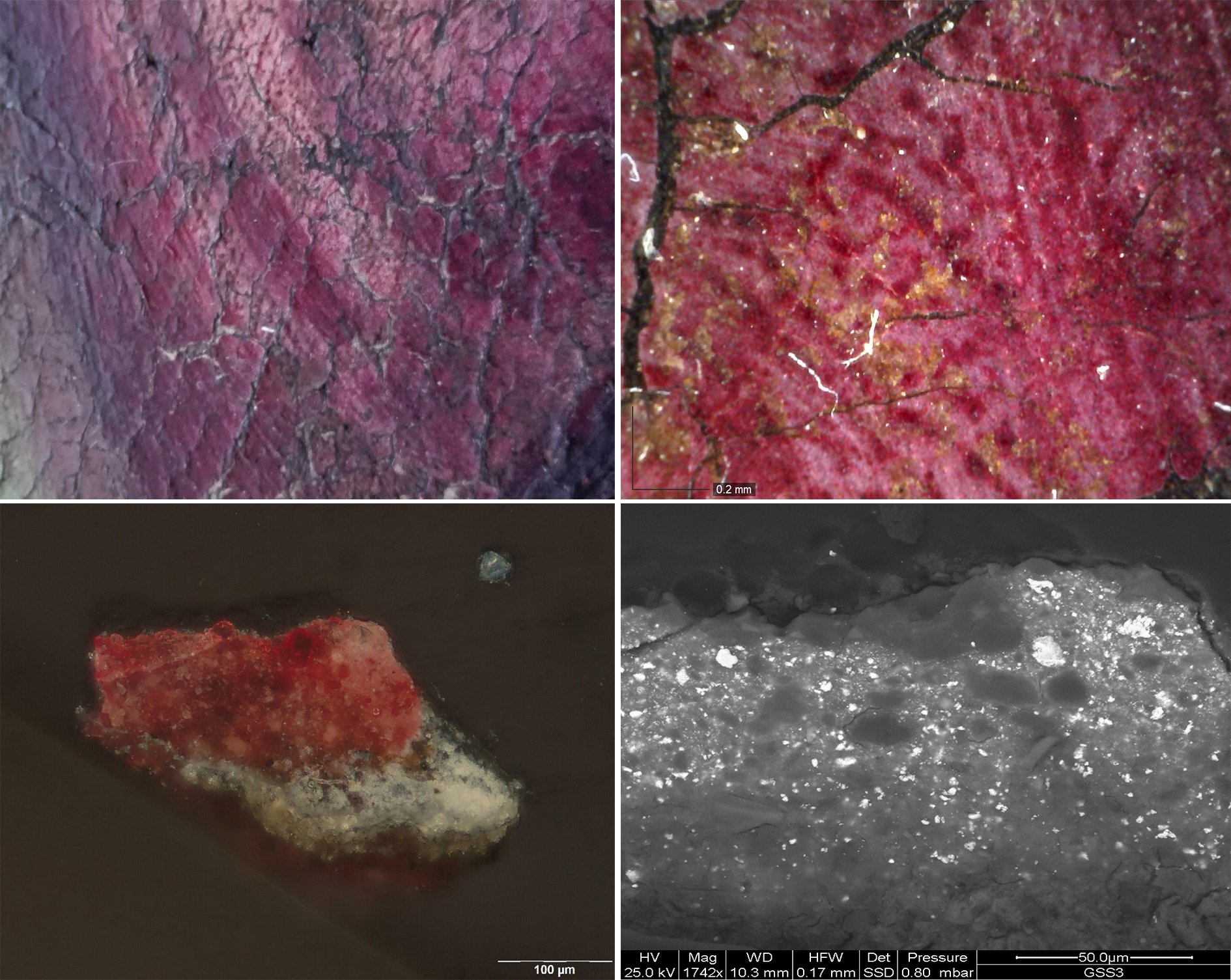 Fig. 13
Fig. 13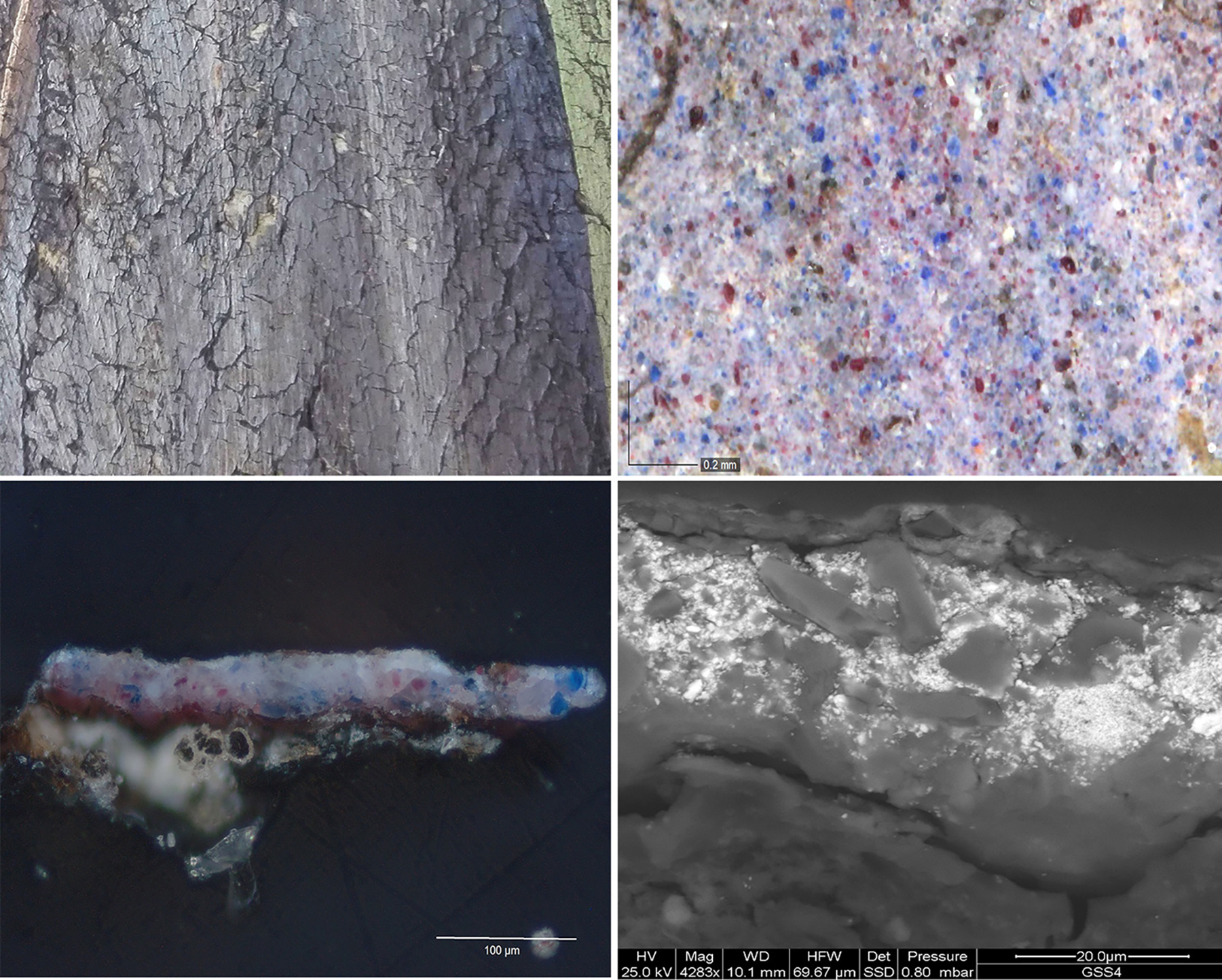 Fig. 14
Fig. 14Santi’s use of colors is generally bright, most notably in the areas containing light and midtoned greens, which are remarkable for their brilliance obtained through the artist’s particular approach to paint mixtures and layer structures. The distribution of various pigments can also be mapped out using false-color IR images (Fig. 15a–b), where ultramarine is depicted in the pink and red areas, verdigris in blue zones, and azurite in pale blue-gray.
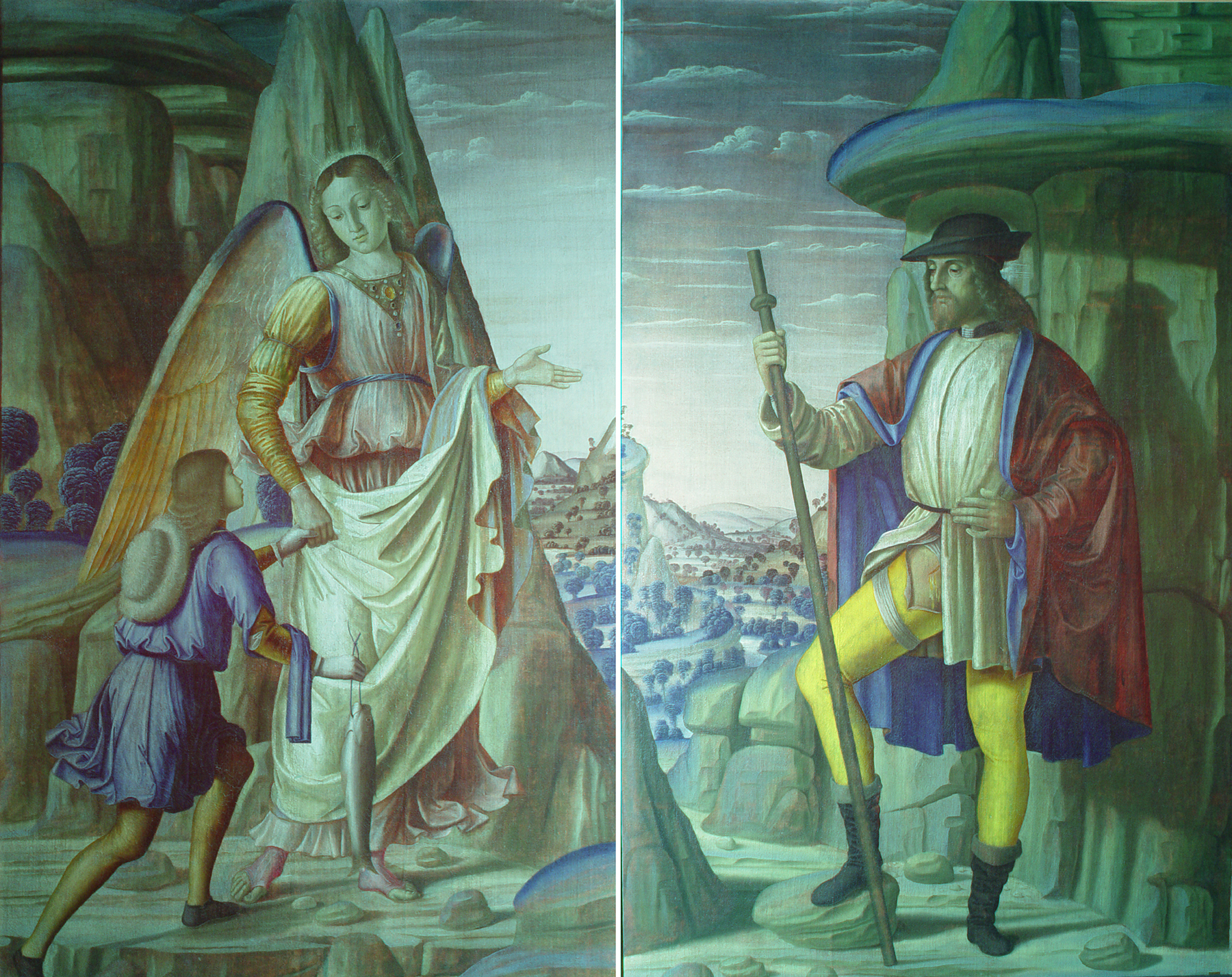 Fig. 15
Fig. 15Conclusion
The examination of the two canvases by Santi has not only enriched current knowledge of this artist, whose production has been the subject of recent diagnostic attention, but also permitted a reflection on the early use of herringbone-linen canvases for oil painting.
It is difficult to believe that the use of such canvas supports was accidental, when the painter could have used wood, which was more common in Santi’s practice. As this is evidently not a question of processional banners, it is possible that the painter decided to experiment with a canvas support not typically used by other artists in his area, but that he may have heard about because it was sometimes used, although rarely, in the Veneto area for large paintings. Or he could have seen some finished works on this fabric, and thought it could be more stable than plain-weave linen canvas, and more intriguing in relation to the optical effects that could be obtained.
Santi used a thin gesso ground without significantly reducing the canvas texture. On the contrary, it seems he tried to exploit the three-dimensional effect of the fabric to give a greater materiality to the work, as can also be seen in the thin layers containing red lakes.
We can only imagine how Santi’s painting could have evolved in the following years if he had not died prematurely, perhaps opting for more frequent use of the canvas support—a more practical and modern practice—and perhaps eventually modifying his pictorial technique as a result. After all, a predisposition to experimentation clearly emerges from the technical study of his works.
In addition, the identification of transparent glass particles, sometimes abundant, in Santi’s panel and canvas oil paintings, indicates this use too was not fortuitous, and suggests he encountered this practice after having seen Justus van Ghent working in Urbino. Moreover, Santi may have procured those painting materials through the workshop he inherited from his father, Sante. The observation of the cross-sections seems to indicate that the glass had not only the role of a dryer, at least in some mixtures such as verdigris and lead-tin yellow—two pigments that do not normally have drying problems—and in the thinner, faster-drying layers: it was most likely used as a filler (or extender), both for its optical and its chemical properties, to maintain the transparency of the glaze and avoid particular craquelure. We cannot exclude the possibility that glass was also used to increase the volume of a layer and avoid the use of too much colored pigment.34
The relations and exchanges of technical knowledge between Santi and Perugino are still waiting to be deepened, as well as the possibility that Raphael’s practice of using glass derives from the roots of this practice in the paternal workshop that he inherited.
Authors’ Bios
Gianluca Poldi After the degree in Physics, he took a PhD in Conservation Science and one in Humanities. Specialised in non-invasive analyses of polychrome artefacts using portable instruments and in technical art history, he worked with some Italian universities and private laboratories. Both as a freelance and as a collaborator of the University of Bergamo (Italy) he has been a consultant for many exhibitions and scientific projects, examining thousands of works in museums, churches and private collections in Italy and abroad, and dedicating many analytical systematic studies to old master painting, including Italian Renaissance (Ferrarese School, Antonello da Messina, Giovanni Bellini and his workshop, Cima da Conegliano, Bramantino, Leonardo da Vinci’s and his and his milieu’s drawings, Giorgione, Titian, Lotto, Tintoretto,…), to 18th-19th century (from Tiepolo to De Nittis, Boldini, Segantini and Divisionist painters) and to Avant-garde artists (Divisionists and Futurists up to de Chirico and Fontana). He published more than 200 works including essays, books and scientific papers. Email: g.poldi@gmail.com
Maria Letizia Amadori Maria Letizia Amadori from 1998 to 2000 has been researcher at the National Research Council, first in Rome and then in Faenza, dealing with archaeometry of stone and ceramic materials. Since 2001 she is Professor of Chemistry for Cultural Heritage at the University Carlo Bo of Urbino and she has been supervisor of more than 100 degree thesis. She carries out research activity related to the knowledge of the cultural heritage materials and to the related conservation problems with the aid of non-invasive and micro-invasive methodologies. She has coordinated several national and international projects. Her main research interests and competences concern the application of traditional and advanced techniques to the study of stones, ceramics, paintings and polychrome artworks in general. She has published more than 140 scientific papers, in national and international journals and two monographs. Email: maria.amadori@uniurb.it
Valeria Mengacci is a restorer and conservator with a master’s degree in conservation and restoration of Cultural Heritage from the University of Urbino. She is an expert in wood and canvas paintings, wooden sculptures and artifacts in synthetic materials assembled or painted. Currently, she works at the University of Urbino focusing her research on scientific investigations of painting materials. As a part of this collaboration, since 2018 she has been involved in several projects such as those on the Persian site of Persepolis and on Giovanni Santi. Email: valeria.mengacci@uniurb.it
Notes
The patronymic Santi, meaning “of Sante,” was also given to Raphael: Raffaello Sanzio. ↩︎
Consisting of almost twenty-three-thousand verses, the poem takes the form of a long historical epic tale, which in turn provides an important source for the reconstruction of Italian court society during this period, as well as a document of the most important Italian and Flemish artists known to have been operating on the peninsula at this date. Among the twenty-seven prominent painters cited by Santi, he remarks particularly on the skills of Andrea Mantegna, Verrocchio, Leonardo da Vinci, Piero della Francesca, Melozzo da Forlì, and Perugino. Franco Tomasi, “L’opera letteraria di Giovanni Santi,” in Giovanni Santi: “da poi . . . me dette alla mirabil arte de pictura,” ed. Maria Rosaria Valazzi (Cinisello Balsamo: Silvana, 2018), 164–65. ↩︎
For the catalog, see Maria Rosaria Valazzi, “Giovanni Santi pittore poeta scenografo imprenditore,” in Valazzi, Giovanni Santi, 15. The exhibition Giovanni Santi: “da poi . . . me dette alla mirabil art de pictura,” was held in the National Gallery of the Marche, Palazzo Ducale di Urbino, November 30, 2018– March 17, 2019. Archival sources reveal that Santi’s workshop hosted the painter Piero della Francesca and also that he was acquainted with Pietro Perugino, the artist who famously trained the young Raphael. Anna Falcioni, “I documenti degli archivi urbinati su Giovanni Santi, in Valazzi, Giovanni Santi, 243. During the late fifteenth century, Santi probably held a monopoly over artistic production in Urbino. Valazzi, “Giovanni Santi pittore poeta scenografo imprenditore,” in Valazzi, Giovanni Santi, 15. ↩︎
Maria Letizia Amadori and Gianluca Poldi, “La tecnica pittorica di Giovanni Santi,” in Valazzi, Giovanni Santi, 259–76. We refer to this essay for a general understanding of Santi’s technique, as well as an indication of the instruments and methodologies used, which include IR reflectography (IRR) performed in two IR bands (850–1000 nm and 1000–1700 nm), false-color IR (IRFC or IRC), diffuse and raking light, UV-induced fluorescence (UVF), surface microscopy (50x and 230x), reflectance spectroscopy (360–740 nm, i.e., vis-RS), EDXRF, cross-sections examined by optical microscopy (OM) including UV light, ESEM-EDX; some samples have been subjected to FTIR, micro-Raman, and GC-MS analysis. The complete version of that contribution, which was printed incompletely due to a pagination error, can be found here (accessed March 12, 2021):
https://www.academia.edu/38204086/M_L_Amadori_G_Poldi_La_tecnica_pittorica_di_Giovanni_Santi_VERSIONE_CORRETTA . ↩︎
The integrated analytical methods have been employed in different case studies, including Maria Letizia Amadori et al., “Lorenzo Lotto’s Painting Materials: An Integrated Diagnostic Approach,” Spectrochimica Acta Part A: Molecular and Biomolecular Spectroscopy 164 (2016): 110–22. ↩︎
Jill Dunkerton et al., Giotto to Dürer: Early Renaissance Painting in the National Gallery (New Haven: Yale University Press, 1991), 161–62. ↩︎
Valazzi, Giovanni Santi, 104–6 (cat. entry by Maria Rosaria Valazzi). ↩︎
Valazzi, Giovanni Santi, 121–22 (cat. entry by Agnese Vastano). The art historian Agnese Vastano dates the Urbino canvases to 1494–95, while also hypothesizing the participation of a “new” collaborator (as Santi died in 1495), to justify their considerably higher quality. Taking into account Santi’s best works, we do not think any collaborator is needed to explain their quality, style, and technique. ↩︎
Ranieri Varese, Giovanni Santi (Firenze: Nardini, 1994), 253–55. ↩︎
Varese, Giovanni Santi, 253. ↩︎
Simona Rinaldi, Storia tecnica dell’arte, materiali e metodi della pittura e della scultura (secc. V–XIX) (Rome: Carrocci, 2011), 171. ↩︎
Valazzi, Giovanni Santi, 100–102 (cat. entry by Alessandro Marchi). ↩︎
For painting on canvas, see Claudio Seccaroni, “La tempera su tela nelle fonti quattrocentesche e cinquecentesche,” in Lorenzo Lotto: Il compianto sul Cristo morto; studi, indagini e problemi conservativi; Atti della giornata di studio (Bergamo, 14 dicembre 2001) (Cinisello Balsamo: Silvana Editoriale, 2002), 99–112. ↩︎
Nicoletta Torrioli, “Le tele per la pittura,” in I supporti nelle arti pittoriche: storia, tecnica e restauro, ed. Corrado Maltese (Milano: Mursia, 1990), 58. ↩︎
Torrioli, “Le tele per la pittura,” 50. ↩︎
For good images, see Stefania Mason, Carpaccio: The Major Pictorial Cycles (Milan: Skira, 2000), figs. at pages 41–64, 77–79. Carpaccio seemed to prefer the twill and herringbone supports for his larger works. ↩︎
Gianluca Poldi and Giovanni C. F. Villa, “Schede scientifiche,” in Catalogo scientifico delle collezioni: I. Pinacoteca di Civica di Vicenza; dipinti dal XIV al XVI secolo, ed. Maria Elisa Avagnina, Margaret Binotto, and Giovanni C. F. Villa (Cinisello Balsamo: Silvana, 2003), 529–31, no. 8. ↩︎
Chiara Rigoni, “Il polittico di Arzignano: presenze squarcionesche nel territorio vicentino,” in Francesco Squarcione: “pictorum gymnasiarcha singularis” atti delle giornate di studio (Padova, 1998), ed. Alberta De Nicolò Salmazo (Padua: Il Poligrafo, 1999), 89–99; Bensi, “Gli esordi,” n. 40, p. 28. ↩︎
Mariolina Olivari, “Michele da Verona: la Crocifissione di Brera. Note in occasione del restauro (2003–2005),”Arte Lombarda 153, no. 2 (2008): 92. ↩︎
Paolo Bensi, “Gli esordi della pittura su tela in Italia attraverso le fonti medievali e rinascimentali,” Arte Lombarda 153, no. 2 (2008): 26. ↩︎
Dunkerton et al., Giotto to Dürer, 161–62. ↩︎
One meter is the average recurring width of the pieces used in the canvases, a standard measure due to the width of contemporary looms. Torrioli, “Le tele per la pittura,” 76. ↩︎
Francesca Bottacin, “Il Redentore benedicente della Ca’ d’Oro: restauro e ricerche per nuove ipotesi attributive,” Quaderni della Direzione Regionale Musei Veneto 6 (Venezia: Polo museale del Veneto, in press); Sophie Scully and Christine Seidel, “A Tüchlein by Justus van Ghent: The Adoration of the Magi in the Metropolitan Museum of Art Re-Examined,” Journal of Historians of Netherlandish Art 8, no. 1 (Winter 2016): 1–29, DOI: 10.5092/jhna.2016.8.1.3. ↩︎
Carried out using both a Si-detector camera (ab. 850–1000-nm spectral range) and an OSIRIS IR camera, with InGaAs detector (ab. 1000–1700 nm range). For a broader discussion and some images, see Amadori and Poldi, “La tecnica pittorica di Giovanni Santi,” 263–70. ↩︎
Amadori and Poldi, “La tecnica pittorica,” 271–76. ↩︎
Maria Letizia Amadori et al., Spectroscopic and Imaging Analysis on Panel Paintings by Giovanni Santi, Raphael’s Father: Materials and Technique (forthcoming). ↩︎
Jill Dunkerton, “Osservazioni sulla tecnica della Madonna londinese di Giovanni Santi,” in Giovanni Santi: Proceedings of the International Symposium (Urbino, 17–19 marzo 1995), ed. Ranieri Varese (Milano: Electa, 1999), 58; Marika Spring, “Colourless Powdered Glass as an Additive in Fifteenth-and Sixteenth-Century European Paintings,” National Gallery Technical Bulletin no. 33 (2012): 18. ↩︎
Francesca Bottacin, Ancora sul fiamminghismo di Giovanni Santi: novità e precisazioni, in Valazzi, Giovanni Santi, 36. ↩︎
Maria Letizia Amadori and Gianluca Poldi, “I materiali e la tecnica pittorica della Comunione,” in La Comunione degli Apostoli di Giusto di Gand, ed. Francesca Bottacin (Padua: CLEUP, in press). ↩︎
See Amadori et al., “Lorenzo Lotto’s Painting Materials,” 118. ↩︎
David Hradil et al., “Microanalytical Identification of Pb-Sb-Sn Yellow Pigment in Historical European Paintings and Its Differentiation from Lead Tin and Naples Yellows,” Journal of Cultural Heritage, no. 8 (July 2007): 384. ↩︎
Marika Spring, “Raphael’s Materials: Some New Discoveries on their Context within Early Sixteenth-Century Painting,” in Raphael’s Painting Technique: Working Practices Before Rome, Proceedings of the Eu-ARTECH workshop, ed. Ashok Roy and Marika Spring (Firenze: Nardini, 2007), 79; Elisabeth Martin and Jean Paul Rioux. “Comments on the Technique and the Materials Used by Perugino, through the Study of a Few Paintings in French Collections,” in The Painting Technique of Pietro Vannucci Called ‘Il Perugino,’ Proceedings of the Eu-ARTECH workshop, ed. Giovanni Brunetti, Claudio Seccaroni, and Antonio Sgamellotti (Firenze: Nardini, 2004), 51–52. ↩︎
Valazzi, Giovanni Santi, 121–22 (cat. entry by Vastano). ↩︎
The use of ground transparent glass mixed to different pigments in various color layers, was also noted in Lotto’s works, since his early works in the Marche region (Recanati) in 1508: Amadori et al., “Lorenzo Lotto’s Painting Materials,” 115, 117. ↩︎
